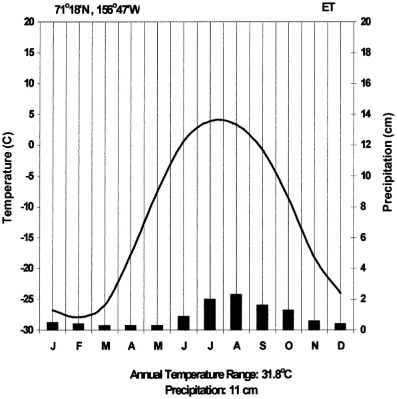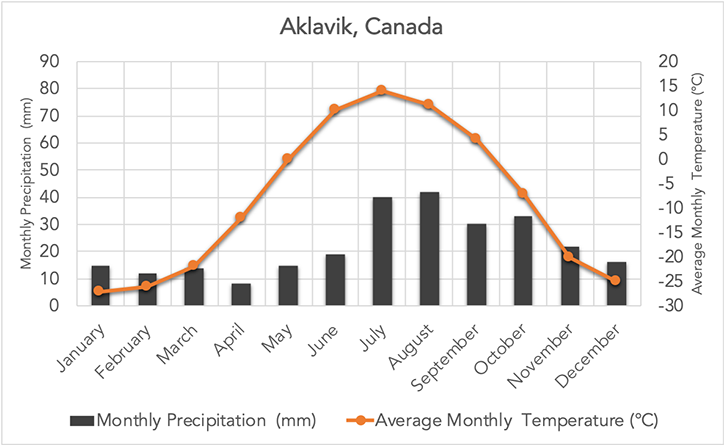Describe the Climate of the Tundra
The vegetation and animals in extreme climate. The most severe occur in the Arctic regions where temperatures fluctuate from about 40 F 4 C in midsummer to 25 F 32 C during the.
Tundra climates vary considerably.

. The musk ox Arctic hare polar bear Arctic fox caribou and snowy owl are among the animals that live in the tundra. The term tundra comes through Russian тундра tundra from the Kildin Sámi word тӯндар tūndâr meaning uplands treeless mountain tract. The tundra is the coldest biome on Earth having average annual temperatures ranging from -40F in the winter to 65F in the summer.
Using a well labelled diagram explain how each of the following features were formed. Average precipitation in the Arctic Tundra ranges from 6 to 10 inches a year and the majority falls as snow. Tundra comes from the Finnish word tunturi meaning treeless plain.
The tundra biome has a harsh frozen climate with low rainfall and high winds. Extreme heat with heavy rain for several months B. Leaves falling off.
Arctic tundra alpine tundra and Antarctic tundra. There is a broad temperature range. Short summers long winters and permafrost.
It is noted for its frost-molded landscapes extremely low temperatures little precipitation poor nutrients and short growing seasons. Composite Volcano 6 marks ii Volcanic plug. Cold windy and dry.
Explore the unique landscape of the tundra and meet. See answer 1 Best Answer. Tundra is the coldest of all the biomes.
This means much of polar ice or snow remains that even in summer and therefore there is a limited soil surface on which plants can grow. Mining and drilling activities are gradually contributing to habitat loss including human habitations. The climate is cold enough that part of the subsoil remains frozen all year.
The high latitudes of polar environments lead to a very cold and dry climate. Which choice best describes that tundra climate. Global warming is known to melt the ice in the tundra and this could.
In physical geography tundra is a type of biome where the tree growth is hindered by low temperatures and short growing seasons. How has the recent negative travel advisories affected Kenyas economy. The absence of trees is a distinguishing aspect of the tundraIt prevents them from taking root and those that do succeed have shallow root systems that arent strong enough to endure heavy winds.
Despite tundra biome having the harshest climate the population of animals here faces different levels of threats. Extremely Cold No Trees Permafrost small plants Polar bears Two seasons. Up to 24 cash back This causes extremely cold temperature this is also why the average temperature is -28 dgC.
This frozen layer of subsoil is. Tundra is a biome that is characterized by a very cold climate. The result is permafrost.
Four equal seasons with few extremes C. Process where a community of animals leaves a habitat for part of the year or part of their lives and moves to habitats that are more hospitable. This topic will explore characteristics such as climate plant animals that make this biome unique.
The temperatures stay below 0C most of the year. The ground remains frozen apart from a. What does the word DECIDUOUS mean.
Tundra along the Colville River Alaska. Long summers short winters and little rain D. Short summer Long winter 2 -10 rain 2.
Which characteristics describe a tundra climate. Describe the TAIGA Coniferous Forest in terms of climate and plants. Tundra areas include Northern parts of Canada Russia and Alaska.
Introduction to Tundra Region Some places on Earth are so extreme that only a few animals and plants can survive there. Average annual temperatures are approximately -28C and temperatures can plummet to as low as -70C. For example hot regions are normally closest to the equator.
Within the Arctic Tundra the climate prevents the soil from getting nutrients. Climate is the average weather conditions in a place over a long period of time30 years or more. Explain four factors which led to the growth of the iron and steel in the Ruhr region of.
Dead organic material functions as a nutrient pool. There are three regions and associated types of tundra. The tundra biome is known for large stretches of bare ground and rock and for patchy areas of low vegetation such as mosses lichens herbs and small shrubs.
Interdependence is the term used to describe how all the biotic and abiotic elements of an ecosystem are dependant on each other. The biggest threat to tundra biome is global warming. And as you probably already know there are lots of different types of climates on Earth.
Flat treeless vegetation region separated from a forest by the tree line. Differentiate between a spring and a well. This is the tundra region.
Describe the TUNDRA in terms of climate plants animals and land. The climate is hotter there because the Suns light is most directly overhead at the equator.

Tundra Climate Location And Definition Springerlink

The Tundra A Powerpoint By Aamir Karan Katie The Tundra The Tundra Is An Icy Freezing Biome That Is Mostly Permafrost It Is The World S Youngest Ppt Download


No comments for "Describe the Climate of the Tundra"
Post a Comment